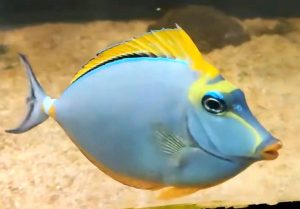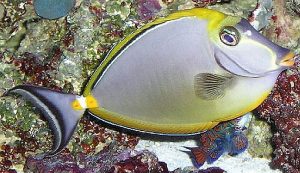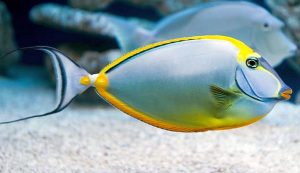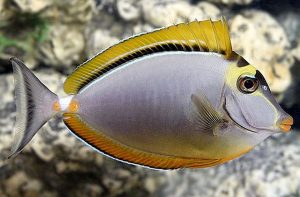Blonde Naso Tang (Naso elegans) known to tropical fish keeping enthusiasts as the Orange Spine Unicornfish, Elegant Tang, or Blonde Lipstick Tang is found in the Indian Ocean and ranges from Red Sea south to Durban, South Africa; and east through the islands of the western Indian Ocean to southwestern Indonesia; including Bali.
The Blonde Naso Tang inhabits the coastal and sheltered reef flats of their range, where they can uaually be found swimming in small groups and schools in open ocean locations above rocky bottoms, at depths from 15 to 98 feet, where they feed on benthic algae and seaweeds.
Although the Blonde Naso Tang is sometimes confused with the Naso Tang (Naso lituratus) which it resembles, the blond dorsal is a dead giveaway.
Adult Blonde Naso Tangs have a dark bluish gray body color, a thin black mask between the eyes and mouth, and yellow orange colored lips. They have a yellow dorsal fin with a blue line at the base, and a black band above it. The pelvic and anal fins are dark brown.
The dorsal and anal fins have a narrow light blue margin and a black submarginal line. The yellowish colored caudal fin has black upper and lower margins and a submarginal black band joining the two. A bright yellow to orange area surrounds the pair of spines on either side of the caudal peduncle at the base of the tail.
Adult males have trailing filaments emanating from the tips of the lyre shaped caudal fin.
Juvenile Blonde Naso Tangs have a lighter gray body color with a yellow stripe on the dorsal and anal fins. They have orange colored lips and a more orange colored lower anal fin. The body colors darken as they mature.
Blonde Naso Tangs from Hawaii are generally more brightly colored than those collected from other areas.
Because adult Blonde Naso Tangs grow to almost 18″ in an aquarium environment, they are best housed in a mature FOWLR or reef tank of at least 180 gallon capacity with a crushed coral or coraline sand substrate, plenty of live rock arranged into large caves and overhangs for them to hide among, and plenty of free swimming space. Like most other Surgeonfish, the Blonde Naso Tang likes water with a moderate to heavy flow that creates strong currents to swim in with higher oxygen levels. Pristine water conditions allow them to thrive.
Along with the normal maintenance required for reef systems, an appropriately sized reef filtration system with a good protein skimmer and multiple power heads
is highly recommended.
Naso elegans are shy, nervous, and very active. A tight fitting lid is recommended to prevent them jumping from the tank when startled. Like other surgeonfish, they become aggressive with other tangs but are peaceful with other less aggressive fish species.
The Blonde Naso Tang is reef safe and will ignore corals, decorative clams, and invertebrates in the system. They benefit greatly from cleaner wrasses, cleaner shrimp, or neon gobies that remove parasites from their skin. They lack a mucus barrier on their bodies which makes them susceptible to marine ich and velvet. Cryptocaryon is very common among tangs but is easily cured with copper drugs in a quarantine tank.
Because of their large size, the Blonde Naso Tang has not been bred in a home aquarium environment. It is possible, but a huge tank would be required.
In their natural habitat Naso elegans display the egg scattering spawning activity typical of the family Acanthuridae. They are broadcast spawners that pair up during spawning. After a brief courtship ritual, the male and female swim up into the water column to the surface where the female releases her eggs and the male immediately fertilizes them. The planktonic eggs drift with the current along the surface until they hatch. The finless fry live off the yolk sack until completely absorbed, at which point they drift to the bottom of the reef feeding on microalgae until they grow into juveniles.
In the wild, Blonde Naso Tangs exclusively feed on marine algae and seaweed. In an aquarium environment with plenty of mature live rock, they will generally accept a variety of foods; the bulk of which should consist of marine algae, seaweed, and other forms of vegetable matter. This will strengthen their immune system, reduce aggression and improve their overall health. Offer dried seaweed tied to a rock or on a veggie clip, and feed at least 3 times per week. Sea Veggies
, Seaweed Salad and Ocean Nutrition
are all ideal products that are very easy to use.
Over time, Blonde Naso Tangs become friendly to their owners to the point of recognizing them and meeting them at the front glass at feeding time. They become tame enough to accept food from the fish keepers hand.
The Blonde Naso Tang (Naso elegans) is available to tropical fish keeping enthusiasts from specialty fish shops, online wholesalers, retailers, and trans shippers at the following approximate purchase sizes from several areas in the Indo Pacific: Small: 1-1/2″ to 2″; Small/Medium: 2″ to 3″; Medium 3″ to 4″; Medium/Large: 4″ to 6″; Large: 6″ to 8″; X Large 8″ to 10″; XX Large 10″ to 12″. Prices vary depending on locale and size but start at around $250.00 for large Sri Lanka specimens to over $1,000.00 for 10″ to 12″ specimens.
Minimum Tank Size: 180 gallons
Aquarium Type: Reef or FOLR
Care Level: Moderate
Temperament: Semi Aggressive
Aquarium Hardiness: Hardy
Water Conditions: 75-79° F, dKH 8-12, pH 8.1-8.4, sg 1.020-1.025
Max. Size: 18″
Color Form: Black, Blue, Orange, Yellow
Diet: Herbivore
Compatibility: Reef
Origin: East Indian and Pacific Ocean
Family: Acanthuridae
Lifespan: Over 8 years
Aquarist Experience Level: Intermediate






One Response to “Blonde Naso Tang (Naso elegans)”
Trackbacks/Pingbacks
[…] the Naso Tang (Naso Lituratus) is sometimes misidentified as the Blonde Naso Tang (Naso elegans) found in the Indian Ocean; Naso elegans have predominantly yellow colored dorsal fins with some […]